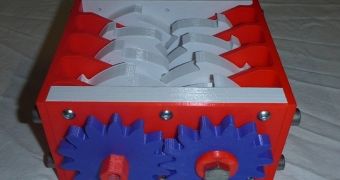Salads and the like are all well and good, but sometimes you need to grind ingredients into powder or paste, rather than just chop them into little bits. That's why compost shredders exist, and, by extension, why Mark Senickey has even had a reason for his latest project.
Shredding things can be fun, but it can also be practical or just plain boring. Think about paper shredders and you have a perfect example of something that can be all three, albeit not at the same time.
Compost shredders, the type used in the kitchen to process ingredients for whatever recipe, easily qualify as practical and possibly fun, if you know what you're doing. Boring too, if you have to cook a marathon.
What they don't usually get labeled as is pioneers, but as it happens, 3D printing technology can make a pioneer out of more or less anything.
Sure, hearing about a 3D printed food shredder isn't as amazing as learning about, say, a 3D printed self-assembling lamp, but it's pretty cool. Especially when you take into account all the complaints that the hype of 3D printing tech is mostly undeserved.
After all, most 3D printers aren't used for anything practical, and the things that do get made with some use in mind are cheap, low-endurance knockoffs of the real thing. At least that's the impression of a certain part of the public.
The new 3D printed compost shredder invented by Mark Senickey for the kitchen is not only practical, but it is cheaper than the ones bought in stores.
It can also withstand 70 NM (Newton-meters) of torque, which means that it can grind to dust or paste any vegetable or fruit, or even other kitchen waste, as long as wood, uncooked meat, stones or bones aren't added to the mix. It will definitely make batter flavors easier to pull off, if nothing else.
The grinder you see before you is the second version that Senickey made. The first was small, and only withstood 25 NM, while the second was capable of 50 NM. The third version, the one with 70 NM support, is now up on Thingiverse, the place where many 3D models are uploaded after they're completed.
Since this is a 3D printed product, you're not expected to buy it. The whole point is to make it yourself, or have it made at a 3D printing store/service. On that note, it should cost less than a typical, manual compost grinder, which is available for $99 / €175 to $175 / €175 online.

 14 DAY TRIAL //
14 DAY TRIAL //